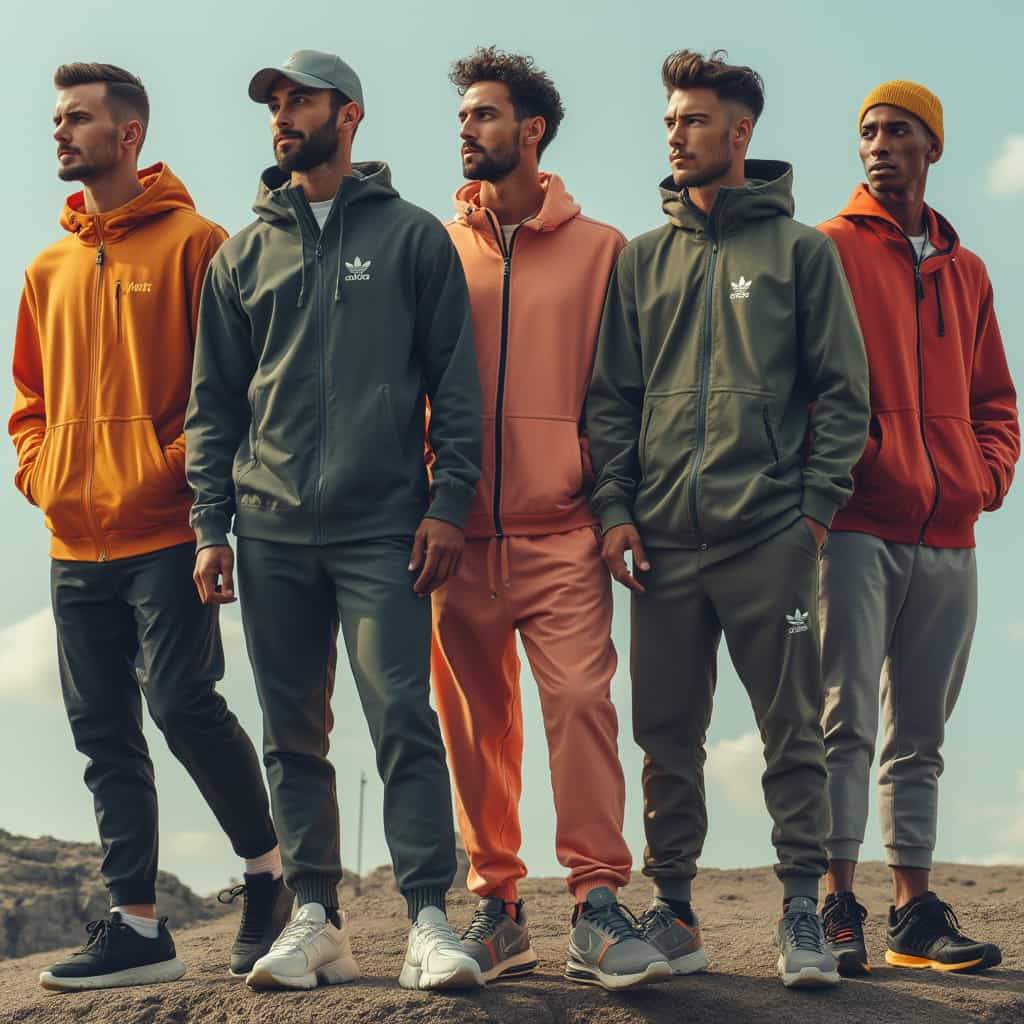The realm of men’s sportswear has undergone a remarkable transformation in recent years, evolving from mere functionality to a fashion statement in its own right. This shift is driven by a combination of technological advancements, a growing consciousness of sustainability, and the meteoric rise of athleisure as a cultural phenomenon.
Today’s male consumers are not only looking for apparel that meets the demands of their athletic pursuits but also garments that align with modern aesthetics and lifestyle preferences. From high-intensity interval training sessions to casual coffee runs, men’s sportswear now caters to a versatile array of needs.
One of the most significant trends in men’s sportswear is the integration of high-performance fabrics. Modern textile technology has given rise to innovative materials such as moisture-wicking fabrics, anti-odor coatings, and UV protection. Nike’s ‘Dri-FIT’ technology and Under Armour’s ‘UA RUSH’ are prime examples, enhancing athletic performance through scientifically-backed textiles.
Sustainability is another powerful current shaping the men’s sportswear market. With an increasing number of consumers expressing concern for environmental impact, brands like Patagonia and Adidas are leading the charge with eco-friendly initiatives. Adidas’ ‘Parley for the Oceans’ collection, made from recycled ocean plastics, and Patagonia’s commitment to using organic cotton and recycled polyester demonstrate a growing commitment to environmentally responsible production.
Emerging brands are making waves in the sportswear domain with innovative approaches. Companies like Ten Thousand and Olivers Apparel focus on minimalist design and superior functionality, attracting a niche yet loyal customer base. Their products often emphasize versatility, allowing consumers to transition seamlessly from gym to street, a hallmark of the athleisure trend.
Geographical differences play a crucial role in shaping men’s sportswear trends. In North America, the athleisure movement is particularly prominent, with brands such as Lululemon gaining significant traction among male consumers. Meanwhile, European markets are witnessing a push towards more fitted and tailored sportswear options, reflecting a broader cultural emphasis on grooming and style.
In Asia, there’s a burgeoning interest in sportswear driven by health and wellness trends. Countries like China and India are experiencing rapid growth in the sportswear segment, with consumers increasingly prioritizing fitness as part of their lifestyle. Chinese brands like Li Ning and Anta are capitalizing on this trend, offering competitive alternatives to Western giants.
The rise of digital platforms has catalyzed an evolution in how sportswear is marketed and sold. Online marketplaces such as Amazon, as well as specialized sportswear retailers, are offering consumers unprecedented access to global brands and exclusive products. Discount events like Black Friday and Cyber Monday often spotlight men’s sportswear, presenting lucrative opportunities for consumers to score premium gear at reduced prices.
Market analysts predict continued growth in the men’s sportswear market, bolstered by ongoing innovations and shifts in consumer preferences. Deloitte’s reports indicate that the global sportswear market is expected to reach a valuation topping $250 billion by 2024. These projections underscore the increasing importance of sportswear as not just functional attire but as a cornerstone of modern style.
Prominent personalities have also played a significant role in shaping men’s sportswear trends. Figures like NBA star LeBron James and soccer icon Cristiano Ronaldo have lent their influence to major brands, pushing the boundaries of sportswear design. These collaborations often result in exclusive collections that blend athletic performance with the latest fashion trends.
The evolution of men’s sportswear aligns closely with broader societal shifts towards health, wellness, and sustainability. While some critics argue that the athleisure trend may only be a passing fad, others assert that its roots in functionality and comfort are deep enough to withstand shifting fashion tides.
As we look towards the future, it’s clear that men’s sportswear will continue to redefine its paradigms, driven by consumer demand for fashion-forward, technologically-advanced, and eco-conscious apparel. Whether it’s through smart fabrics, new sustainable practices, or inventive marketing strategies, the sector remains one of the most dynamic areas of the fashion industry.
You may also like
Women’s Formal Wear: Collections and Market Insights
Explore the latest trends, collections, and market insights into women’s formal wear. Discover global preferences, regional variations, and the best offers currently available for those special occasions.
Men’s Formal Wear 2025: Trends, bold designs and cultural inclusivity
As we approach 2025, men’s formal wear is experiencing a renaissance with an emphasis on sustainability, bold designs, and cultural inclusivity. This exploration delves into the latest trends and offers available on the market, with insights into regional preferences and industry predictions.
Women’s Jeans: New Models and best quality-to-price ratios across different regions
Women’s jeans have become a staple in wardrobes around the globe, with ever-evolving trends and designs. This article explores the latest in women’s denim, from emerging styles to market offers, and provides insight into the best quality-to-price ratios across different regions.
Trends and Deals in Men’s Jeans
In this comprehensive article, we delve into the world of men’s jeans, exploring the latest trends, market dynamics, and new models making waves in the fashion industry. We highlight key geographical influences, provide insights into best quality-price options, and showcase expert opinions on the evolution of this wardrobe staple.
